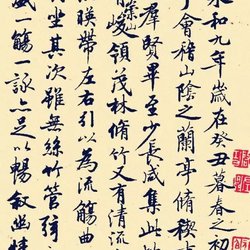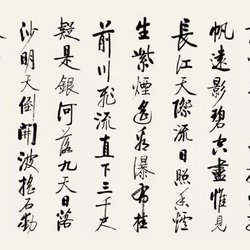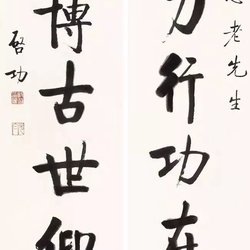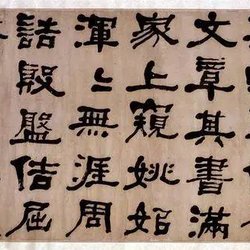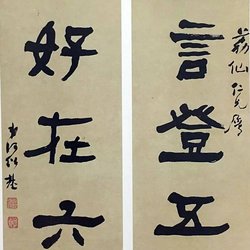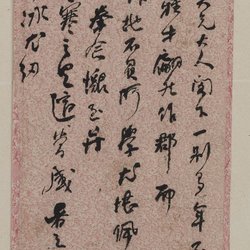Lingu is a subject that no calligrapher can avoid. Whether it is at the beginning of learning calligraphy or successful, Lingu is undoubtedly an important way and source of nourishment to support the continuous development of calligraphy.
1. Never tire of the past
1. Stay true to past times throughout your life
He Shaoji was born in a scholarly family and received a good family education since childhood. His father, He Ling, was an official of the Han Dynasty and became the Minister of the Ministry of Household Affairs. After his death, he specially gave it to the crown prince as Taibao, and gave him the posthumous title Wen'an. He Linghan not only held a prominent position and had a smooth official career, but his calligraphy was also well-known at the time. One of the important reasons for his success in the palace examination was that he was good at calligraphy. He Linghan was well aware of the importance of calligraphy in future imperial examinations, and attached great importance to teaching He Shaoji in calligraphy. Adhering to his family education, the young He Shaoji began to come into contact with Tang steles. He once said: "I was also studying Fule when I was young, and I was studying Pingyuan calligraphy at that time." Because of He Shaoji's diligence and studious, he enjoyed a great reputation during his lifetime, and everyone was competing for the words on the piece of paper. Baozhi, its fakes are also widely popular in the market. In today's popular terms, He Shaoji has become a famous calligrapher, and his works can already be sold for money, but he still perseveres in the ancient times, and even worse in his later years.
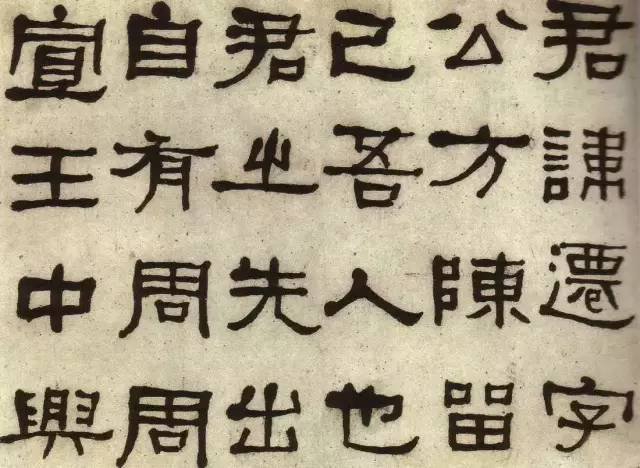
He Shaoji Lin Zhangqian Monument
2. Be diligent and involved in everything
He Shaoji has been closely involved in ancient times throughout his life, and has been involved in all styles of regular script, Xing script, Cao script, seal script and Li script. In terms of regular script, he was originally rooted in Yan Zhenqing, and he worked hard on Yan characters since he was a child. From then on, he extensively studied Tang steles and had a special liking for Ouyang Xun, Ouyang Tong and his sons, especially Xiao Ou. Later, he became obsessed with "Zhang Heinv's Epitaph" and "The Crane Inscription". I started with "The Story of Magu Immortal Altar in Small Characters" in small regular script, and then "Huang Ting" and "Le Yi". In terms of running script, He Shaoji was familiar with Lu Gong's "Struggle for Seats" and Beihai's "Lushan Temple Stele", and also played with Wang Xizhi's "Lanting Preface" and "Holy Teaching Preface" from time to time. In terms of cursive calligraphy, although He Shaoji "didn't study hard in his life", he was still interested. Today, Jie Lin Huaisu's "Zi Xu Tie" has been handed down to the world. In terms of seal script, He Shaoji "started reading "Shuowen" and writing seal script when he was 20 years old." The study of "Shuowen" may have been due to academic needs, but at the same time it enhanced his understanding of the evolution of characters and seal script. Later, especially in his later years, he successively studied various bronze inscriptions such as "Stone Drum Inscriptions", "Maogong Tripod", "Chu Gong Tripod", "Zong Zhou Zhong", "Uncle Bangfu Yan" and so on. In terms of official script, He Shaoji made the greatest effort. Ma Zonghuochang said: "Haosou is very diligent in dividing books and reading extensively, and he is very diligent and unparalleled in the world." He Shaoji only has more than ten kinds of scripts that have been handed down to this day. , such as "Zhang Qian Stele", "Ritual Stele", "Hengfang Stele", "Cao Quan Stele", "Yiying Stele", "Ode to the West", "Shi Chen Stele", "Huashan Stele", " "Ode to the Stone Gate", "Wu Rong Stele", etc.
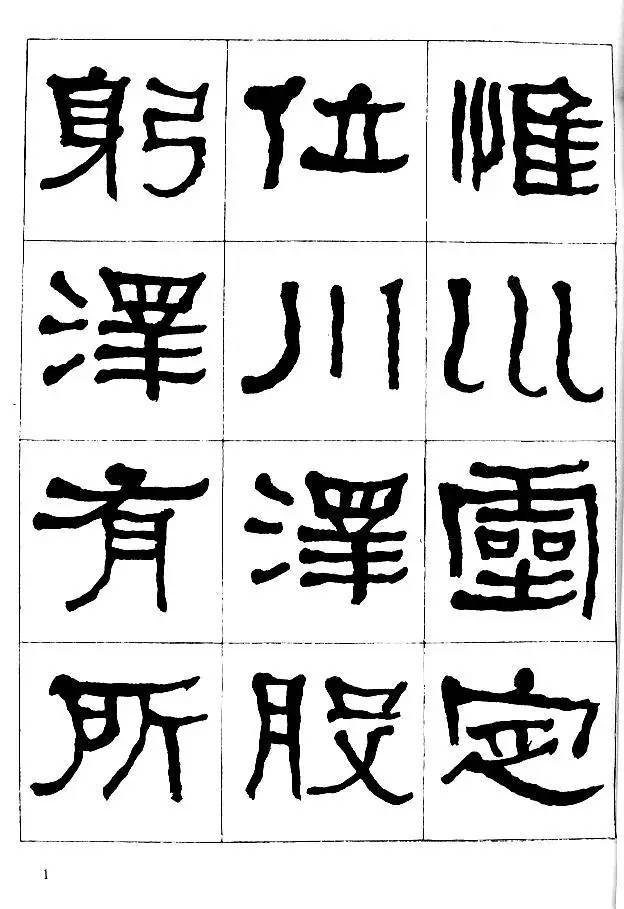
He Shaoji Ode to the Stone Gate
2. There are laws based on ancient times
It goes without saying that the importance of lingu is important to the study of calligraphy. However, many issues such as what to lingu and how to lingu are matters of opinion and wisdom. In this regard, He Shaoji not only showed his compliance with some inherent laws, but also continued to try and develop unusual processing methods based on in-depth practice.
1. Be broad-minded in approach and don’t limit your opinions to the time.
The first question to be faced when Lin Gu is about what to make. This choice is closely related to the insight, aesthetics, calligraphy thoughts of the Lingu and the era in which he lives. He Shaoji's wide range of methods broke through the prevailing ideas in the calligraphy world at that time about the division of books into north and south and the dispute between inscriptions and inscriptions. After practicing more and more, he showed extraordinary courage and vision. Ma Zonghuo admired his writing and said: "However, I saw that he was writing the "Preface to the Collection of Holy Teachings of Huairen", and the style and flow directly created the mystery of Shanyin Hall. I know there is nothing we can do to help.”
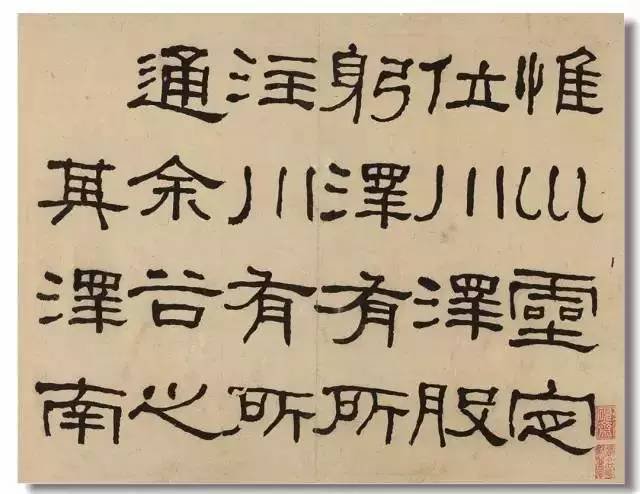
He Shaoji Ode to the Stone Gate
2. Seal characters are divided into roots and all styles are understood.
Judging from the various styles of calligraphy, He Shaoji studied the two types of seal script the most during ancient times. Especially in his later years, he took the study of various bronze inscriptions and Chinese steles as his daily lessons. Why does He Shaoji prefer seal writing so much? This is complementary to his consistent view of calligraphy. In his teacher Ruan Yuan's "Lun of the Northern and Southern Calligraphy Schools" and "Lun of the Northern Stele and the Southern Tie", several key words are repeatedly mentioned, namely "the legacy of seal script and official script", "the legacy of seal script and official script, eight points, and cursive script", "Liquing the ancient ideas" and "the ancient methods". Much the same as He Shaoji, He Shaoji also regards ancient meaning as the criterion for considering his calligraphy. Specifically, the ancient meaning in his mind is the meaning of seal division. In the process of continuous exploration, He Shaoji realized more and more deeply that the seal script is the source and foundation of calligraphy: "The true practice originally came from the Li Fenbo, and the root is the seal script." Therefore, He Shaoji not only practiced a lot of the previous People's seal script and official script also uniquely learned the meaning of seal script from the regular script and running script of their predecessors. In He Shaoji's view, although there are many differences in calligraphy fonts, they are not incompatible with each other. The meaning of seal script exists not only in seal script and official script, but also in regular script, running script and cursive script. Therefore, he does not treat each body's learning in isolation, but interconnects it with each other. In turn, due to constant penetration and integration, his seal writing naturally has the flavor of regular script, running script and cursive script.
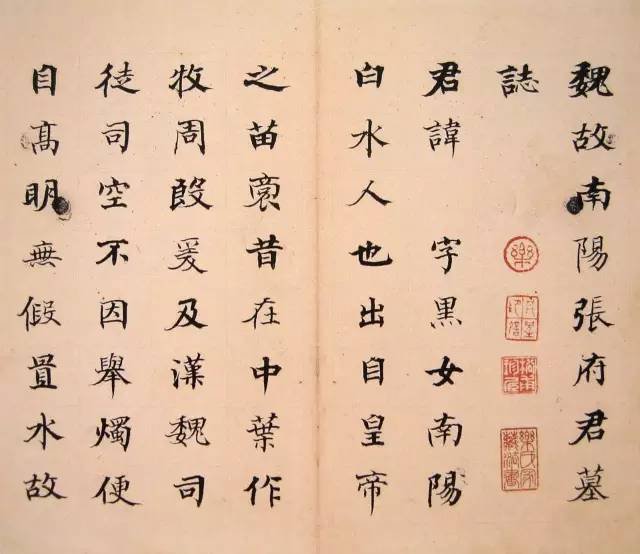
He Shaoji Lin Zhang Heinv’s Epitaph
3. From form to spirit, focusing on meaning
As far as the general rules of copying are concerned, there are roughly levels of copying, copying, and reading, and copying has distinctions such as actual copying and meaning copying. He Shaoji once claimed: "I also learned copying when I was young. At that time, I was studying Pingyuan calligraphy. All the things I drew were close to Pingyuan." The so-called copying and hooking are the first steps of copying. At this time, we should use form For Shang. Regarding his skill in copying, Wang Qiangang recorded: "He worked extremely hard on the large characters of "Magu Xiantan Ji", "Li Yuanjing Stele" and "Fahua Temple Stele"." He Shaoji is now Chen Song's Nantong Lin. Tan Yankai once commented on this book: "Taozhou calligraphy is the most accomplished in his later years, but the energy and energy of writing in his early years are beyond the reach of others. This book was written by Mr. Chen Songnan, and it is particularly outstanding." This is a masterpiece created by I-Man, when he was thirty-eight years old." Compared with the original post, this Lin's grasp of the appearance and posture is very good, and it can be called a masterpiece of Shi Lin. From He Shaoji's "Postscript to the Rubbings of Zhang Heinv's Epitaph" "After I got this post, I went to Dengzhou to watch the sea, and then to Chu. The following year, Bingxu entered the capital, Dinghai visited Bian, returned to the capital, returned to Chu, and Wuzi returned to the capital in winter. , and traveled more than 20,000 miles, and he was not in the box all the time. He stayed in the shop outside the boat window, sat quietly and admired, and gained a lot." It can be seen that he did not copy and copy all the time. The so-called "sitting quietly and admiring" That is to say, reading posts, which may be regarded as an important supplement to copying and copying. Hold the rubbings in hand, observe carefully, and understand with your heart. Let your thoughts collide and communicate with the rubbings. Once you have it in your mind, you will naturally gain from writing and copying.
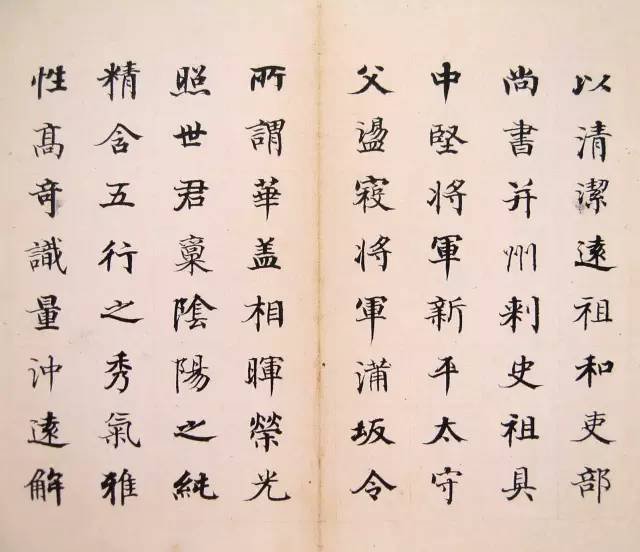
He Shaoji Lin Zhang Heinv’s Epitaph
4. Be exclusive and make bold choices
Although He Shaoji was diligent in copying, he did not approach death blindly. He paid special attention to why he came and what he wanted to get from copying. Ma Zonghuo commented on the stele of Linhan and said: "The stones in Tokyo have been written almost all over, and there may be more than a hundred tongs, and as few as dozens of tongs. Every time I come to a tong, the meaning must be unique, so each tong has its own unique place." "Also said: "Every time I come to a stele, there are as many as several passages, either to take its spirit, or to take its rhyme, or to take its measure, or to take its momentum, or to take its brush, or to take its movement, or to take its Structural distribution. When something is taken from it, the spirit when writing is focused on a certain end, so it seems that nothing is completely similar to the original stele. The ignorant would say that Haosou used his own method to follow the ancients. I don’t know that Haosou wants to be the first. Divide them to their extremes, and then combine them to bring them back together." Using this method to refer to ancient times seems to be very different from the original work and yields very little. In fact, this is the brilliance of He Shaoji. Copying in this way is of course much more profound than just swallowing everything that is similar but not similar. It helps to improve the ability to analyze the work, to deeply understand the true meaning of the original work, and to better digest and absorb it.
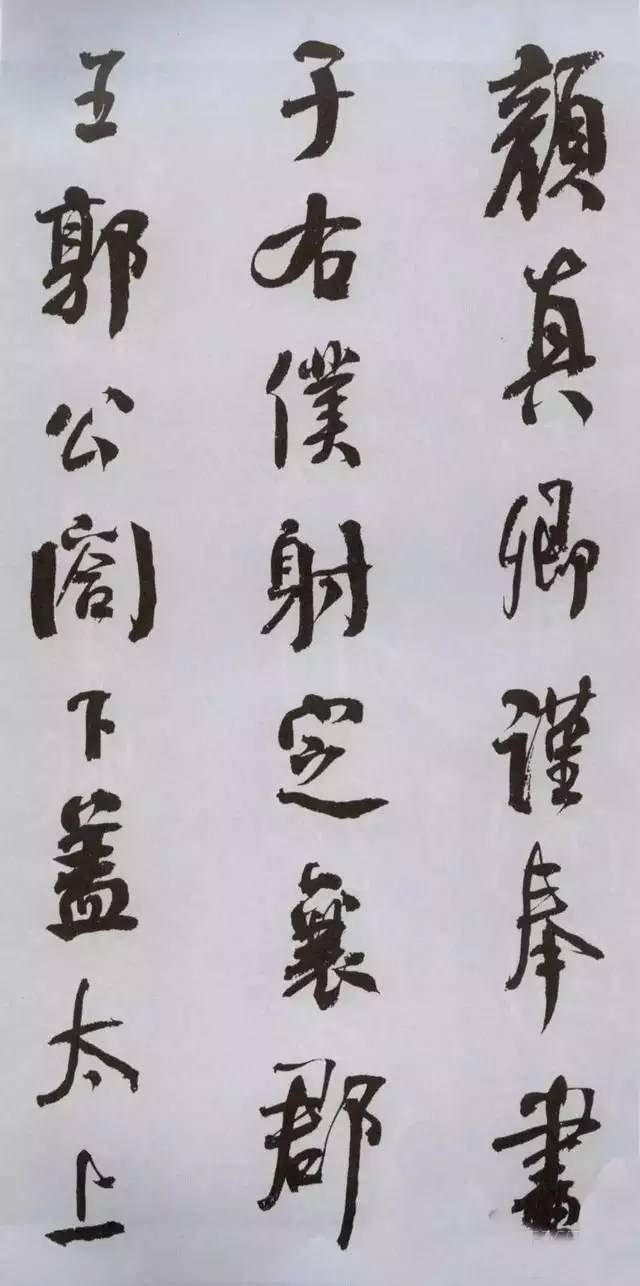
He Shaoji's temporary seat sticker
3. Practical application of ancient times
1. The Six Classics have been given to me, and they have been used by me since ancient times.
He Shaoji once said: "If you don't start a family with poems, words and paintings, it's a waste of energy. However, starting a family doesn't start with poems, words and paintings, but with being a human being. Your own thoughts and words are always the beginning and the end. You have to make up your mind about who you want to be. If you really accumulate strength for a long time, you will achieve something naturally, whether it is a big success or a small success, whether it is Confucianism, chivalry, knowledge, steepness, indifference, splendor, purity, lada, tranquility or indulgence, it is what people do. Establish a method of calligraphy, then work hard on writing, and gradually transfer it, and the art will be perfected and suitable for the person." Whether he can start his own calligraphy family should be the most fundamental destination and the core guiding ideology of He Shaoji's calligraphy practice. He Shaoji said that there are five difficulties in writing: "... even if we study the steles and slips of the ancients and follow the similarities, we cannot form our own way, and it has nothing to do with this matter. This is the second difficulty." This statement also shows that he does not I believe that the difficulty in copying is to be similar to the original work, but the difficulty lies in whether it can become its own style through copying.
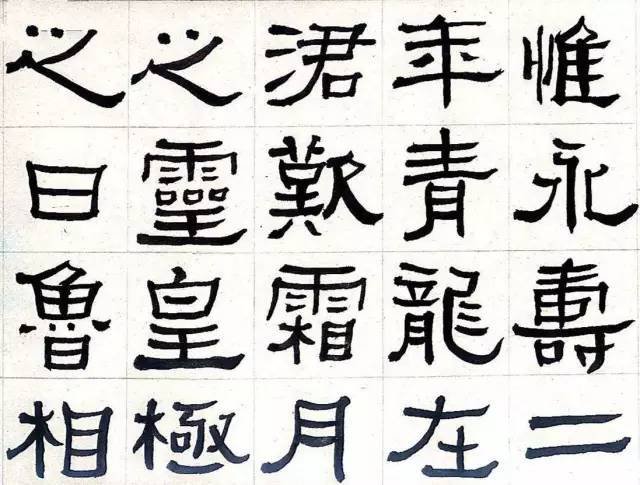
He Shaoji's Ritual Vessel Stele
2. From experience to creation, experience and creation are integrated
Copying is a means, a method, and a way, and its purpose is not to copy for the sake of copying. Copying itself is divided into many methods, including real copying, meaning copying, general copying, section copying, etc. No matter which method, there are only differences in methods between them, but there is no distinction between which one is better and which one is worse. Regarding Linxi, He Shaoji's ultimate goal is to become his own brand, and being independent can only be reflected through creation. Therefore, how to naturally transition from copying to creation is a technical problem that must be overcome. There is no simple or absolute causal or sequential relationship between creation and creation. Since ancient times, accomplished calligraphers have had their own unique methods in dealing with it. He Shaoji is no exception. He successfully solved the transition problem between creation and creation and left a wonderful example for future generations.

